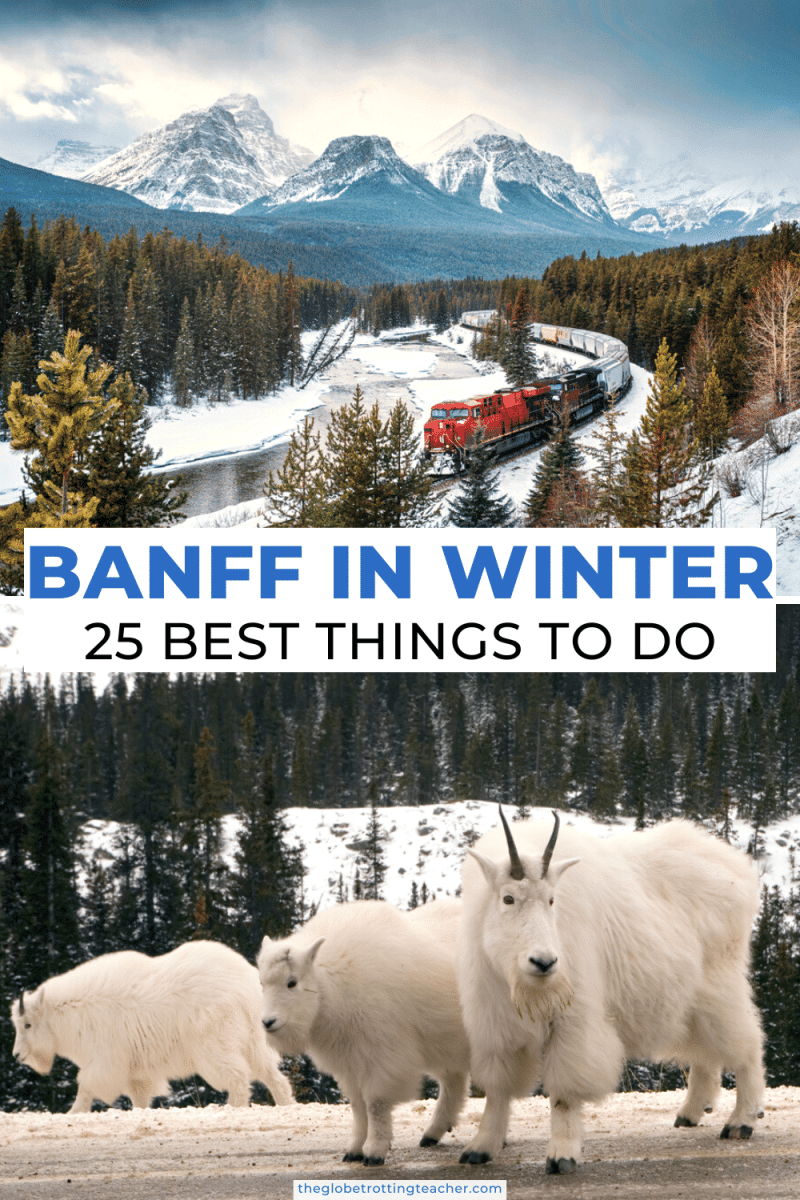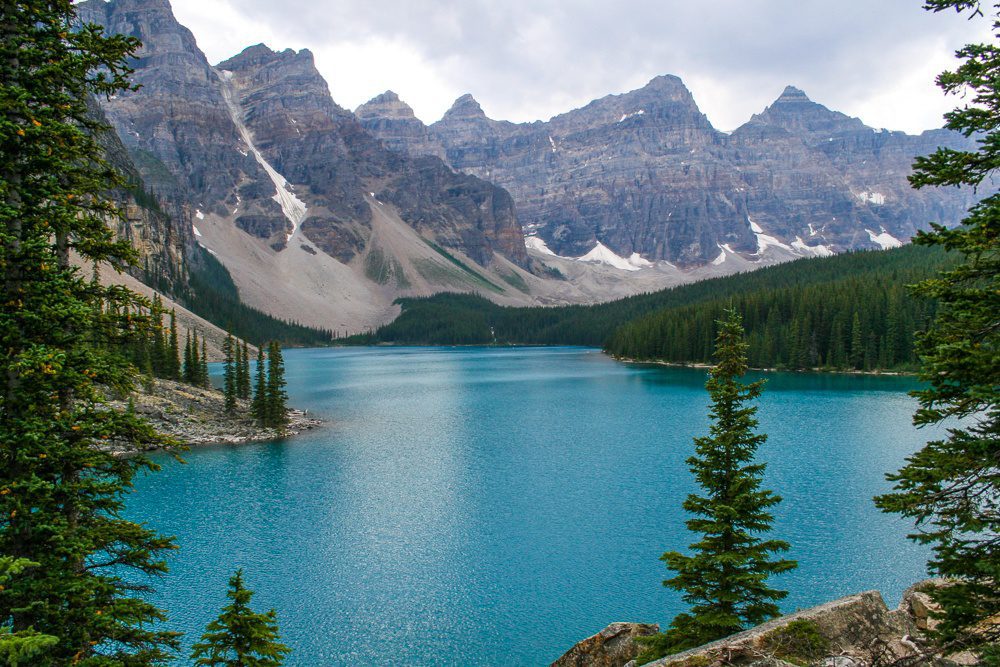The things to do in Banff in winter are the perfect combination of adventurous thrill and winter wonderland!
And lucky for you, there’s an endless number of Banff winter activities to have you swooning over this Canadian Rockies gem. After all, Banff National Park is a UNESCO World Heritage Site, Canada’s first national park, and a bucket list destination for many.
So, whether you’re planning a Banff Christmas or a Banff winter trip, this guide has the best of what to do in Banff in winter to help you plan an unforgettable trip.
Layer up and let’s go!
25 Things to Do in Banff in Winter to Take Your Breath Away
Banff and the surrounding Canadian Rockies are a 4-season destination that attracts millions of people every year. The natural beauty is utterly beautiful no matter when you visit.
But, Banff in the winter dramatically transforms the landscape into a frosty whitescape glistening around a rugged mountain backdrop. This opens up possibilities not available in the warmer months from skiing and ice skating to northern lights and Banff winter hikes.
You’ll never have to wonder about things to do in Banff in winter! In fact, as I was planning my Canadian Rockies itinerary, I realized it just couldn’t be long enough! (To be fair, I felt the same way when I visited Banff in warmer months, too.)
1. Enjoy Some Banff Ski Big 3 Time.
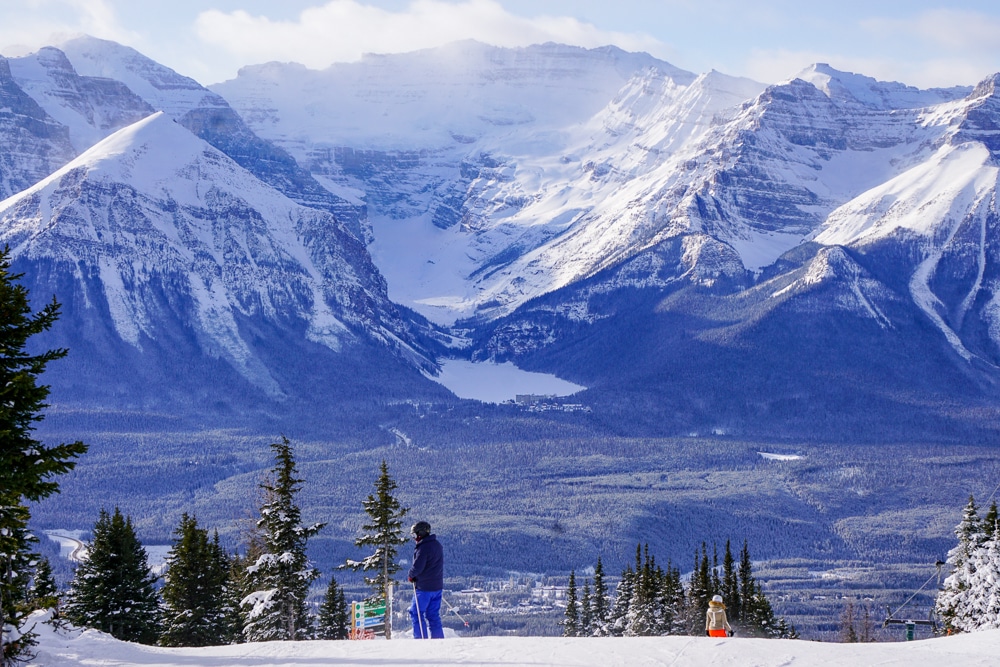
While this might be one of the more obvious things to do in Banff in winter (Mountains + Snow), it’s also strategically placed as #1 on this list for any nonskiers thinking that a Banff winter = only skiing.
The beauty is that the ski resorts are all located within Banff National Park where skiing is just the tip of the iceberg when planning Banff winter activities. For those of you planning to ski in Banff, here’s what you need to know.
Banff and the surrounding area has 3 ski resorts to choose from, Banff Sunshine, Lake Louise, and Mt. Norquay. Together, they are known as the Big 3. You can even use one pass to access all of them.
Collectively, there are 7,748 acres of slopes to ski, with Banff Sunshine and Lake Louise nearly splitting this total. And while Mt. Norquay is the smallest of the Big 3 with only 190 acres, its mighty slopes have helped train Olympic skiers. Regardless of size, there is plenty of powdery snow to go around!
Banff Sunshine is 15-20 minutes by car from Banff and is the sweet spot for intermediate skiers. Sunshine sits on the Continental Divide and has gorgeous wide-open ski runs surrounded by epic mountain scenery. You can even ski into nearby British Columbia.
Lake Louise Ski Resort is a great option for beginners and families. (Although, you’ll find ski runs from beginner to advanced at all 3 Banff ski resorts.) It’s the farthest ski resort from the town center of Banff but worth the drive for the skiing and to see beautiful Lake Louise.
Mount Norquay is the closest to Banff. The ski terrain is steeper here but you’ll also find gentler ski hills below the tree line. Mount Norquay also has tubing (more on this below) and is the only one among the Big 3 to offer skiing at night.
ProTip: If you’re planning to visit Banff in winter, you likely have already packed cold-weather essentials. But, make sure you have the right ski gear packed to ensure a great experience on these world-class mountains!
2. Banff Ice Skating is a Must. (It’s absolutely epic!)
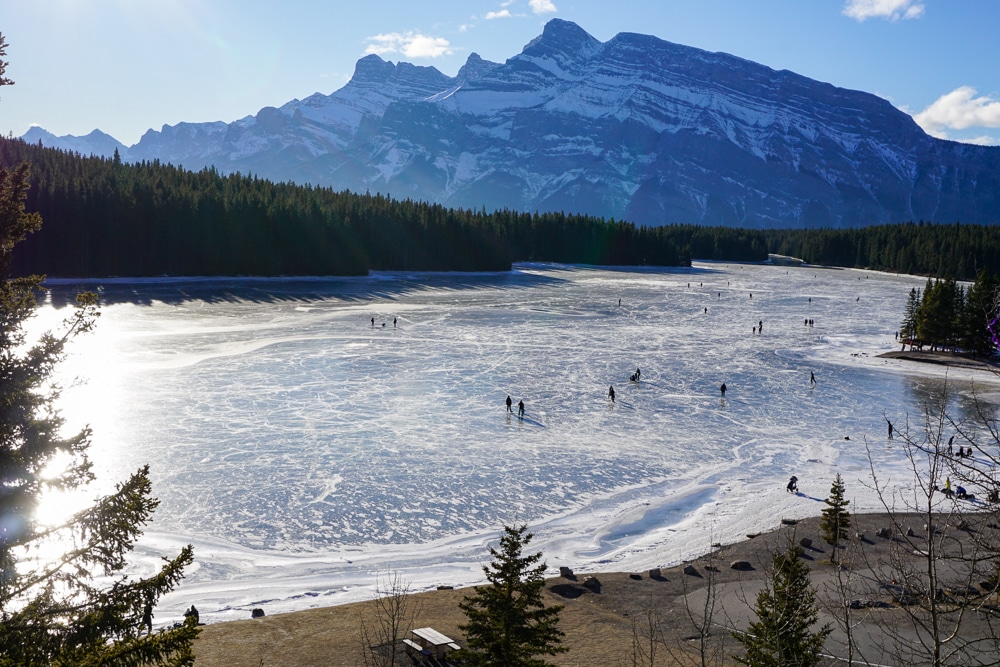
Ice skating in Banff is an absolutely unforgettable experience! If you’re someone like me who lives in a place where winter is cold but not cold enough to freeze entire lakes, you won’t want to miss out on giving this a try.
When the temperatures drop for a sustained period, the ice thickens enough for Banff outdoor skating. The lakes and rivers freeze solid creating glassy rinks surrounded by evergreen trees and jagged, snow-capped mountain peaks.
Two Jack Lake, Johnson Lake, Lake Minnewanka, and the Bow River are among the bodies of water that freeze over and can be skated on. The key to this experience, though, is timing. December and January are when you’re most likely to find a natural ice skating spot with ice that’s thick enough, but also not covered with snow.
These ice skating areas are not maintained so, once they’re snow-covered, the conditions aren’t good for smooth skating without the help of some wind to blow the snow away. That’s why, in particular, this is one of the best things to do in Banff in December, especially if you’re visiting around Christmas like I was.
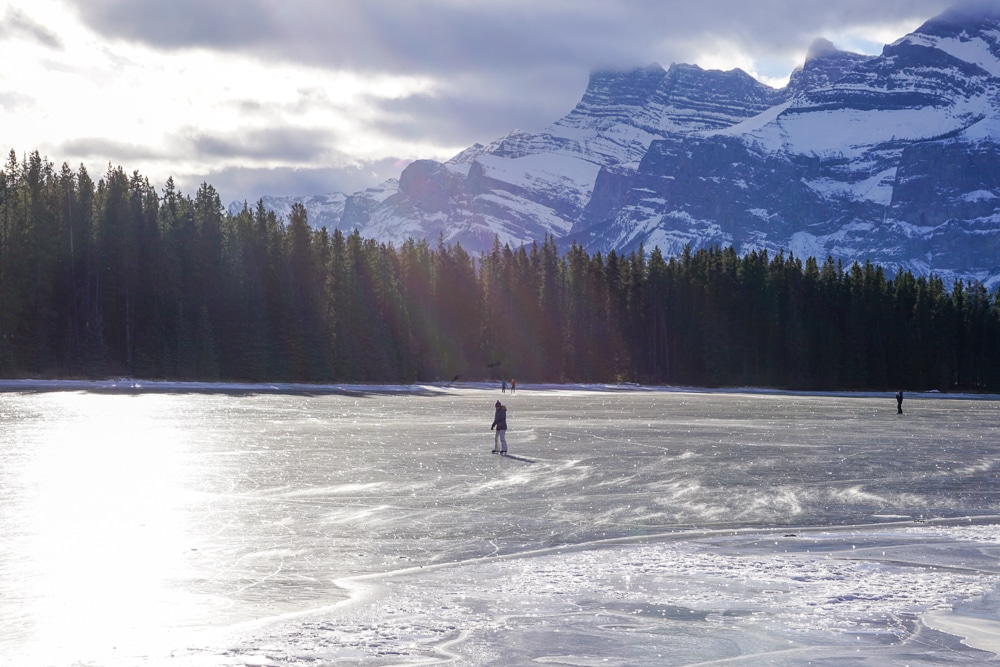
For Banff skate rentals and even hockey sticks, visit Banff Adventures in the center of town. The friendly staff will set you up so you can head off to practice your spins and puck pass.
If you get an ice skating opportunity, look down! On Two Jack Lake, the water is so clear you can see inside the lake. In some spots, you’ll even see frozen methane bubbles trapped under the surface!
ProTip: The Fenlands Banff Recreation Center, on the edge of town, has an indoor rink open to the public with skates available for rental right there. There is a fee to use this rink but you’ll be a bit warmer skating inside. You can also skate outdoors in Fenlands Meadow just behind the recreation center.
3. Ice Skating at Lake Louise is Unforgettable.
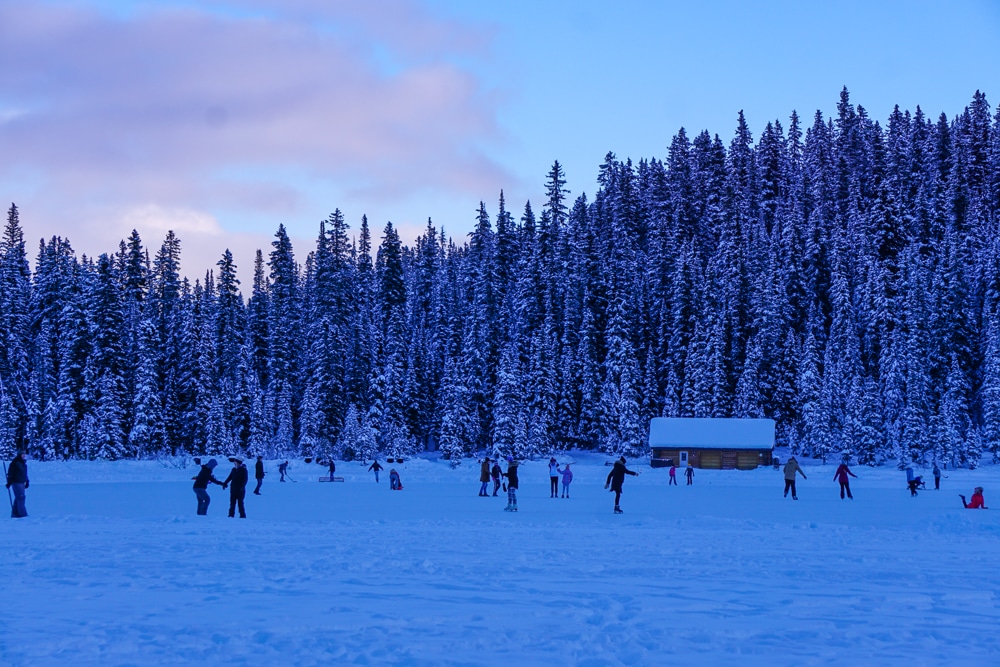
Visiting Lake Louise is one of the top things to do in Banff in winter and at any time of the year. The lake’s fairytale setting is gorgeous year-round. Even better, regardless of when you visit Banff in winter, Lake Louise ice skating is possible.
The Fairmont Chateau Lake Louise, a luxury hotel along the lakeshore, takes care of the natural rink and clears the snow. This makes it the best natural ice skating rink from a safety and skating conditions standpoint throughout the winter.
Add to the festiveness of this winter scene with an ice bar, sleigh rides, and an ice castle around Christmas and you’ll feel like you’re starring in a sequel of Frozen.
Ice skate rentals are available from the lake’s rental shop.
4. Go Tubing in Banff.
No need to be a skier or snowboarder to slide down a snow-covered mountain in the Canadian Rockies!
The Mt. Norquay Tube Park has a magic carpet to carry you and your tube to the top of the slope. The only thing left is the rush of sliding down the hill in your own lane, spinning as you go.
Mt. Norquay’s tubing is open every day, as well as Friday and Saturday nights from 5 pm-9 pm starting at the end of December. If you have a Ski Big 3 pass, tubing is included with your pass.
It’s a great way to enjoy Banff’s incredible natural beauty while giving your leg muscles a break from all the ice skating, skiing, and snowshoeing you’ve been doing.
ProTip: For those who want the simple pleasure of sledding, head just behind the Banff Springs Hotel, on Spray Meadows Hill. There’s a smaller hill for sledding and tobogganing and sleds can be rented in town.
5. Indulge in Cozy Warm Foods.

What is winter without warm comfort food?!
Take a moment to warm up in one of Banff’s cafes with a frothy cup or bowl of warmth guaranteed to ward off even the most persistent chill.
All located within the town of Banff, goodies like this bowl of 5-grain porridge or a steaming cup of coffee from Wild Flour, Whitebark, or Evelyn’s will warm up your insides and can even be carried out if you’re off to your next winter adventure.
6. Ride the Banff Gondola for Insane Rocky Mountain views.
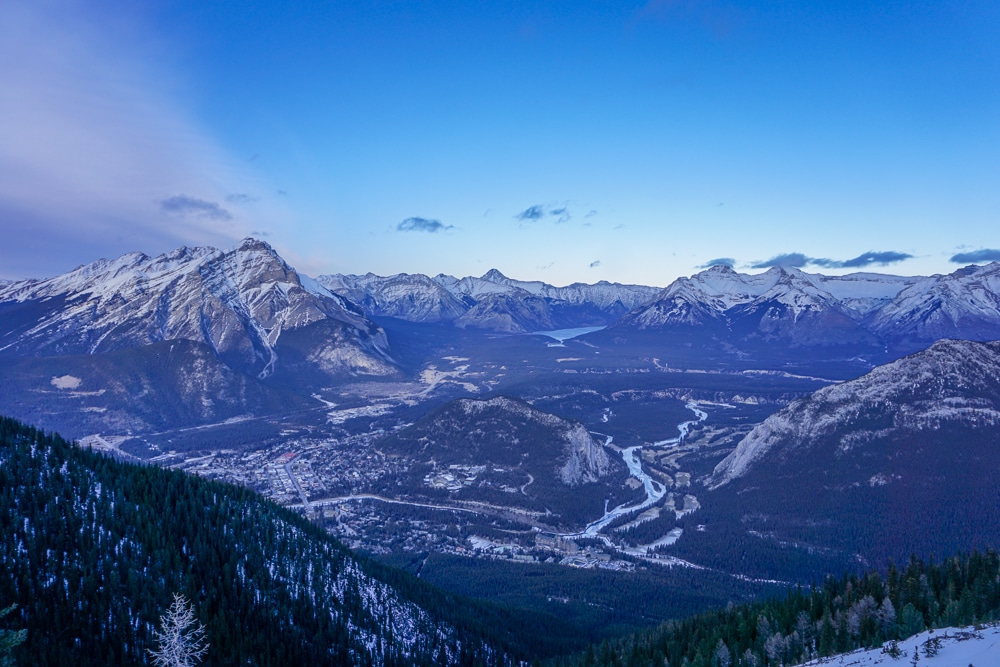
The Banff Gondola is easily one of the best things to do in Banff in winter! The top of Sulphur Mountain offers breathtaking views of Banff, the Bow River, and the magnificent Canadian Rockies that stretch as far as the eye can see. And you can get this birds-eye view all without needing to hike or climb your way there.
The Banff Gondola ride whisks you (warmly) up the 7,486 ft. up to the Sulphur Mountain summit. Once at the top, walk along the Banff gondola skywalk for jaw-dropping 360° Rocky Mountain views with Banff nestled in the valley between them.
At the top, you can also dine at the award-winning Sky Bistro restaurant, an upscale dining option with unparalleled views of the Canadian Rockies. Or savor some of the comfort food at Northern Lights, a buffet-style restaurant also on top of Sulphur Mountain.
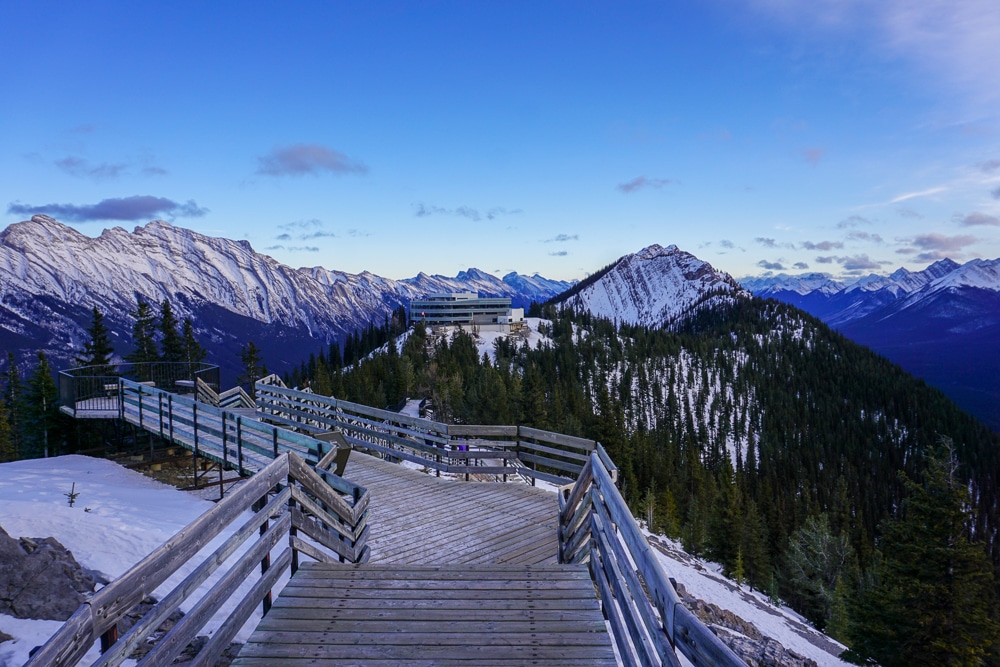
The ticket price for the Banff Gondola fluctuates depending on the day and how far ahead you buy your ticket. It’s worth booking this experience as early as you can and being flexible about which day to go while you’re in Banff to get the best possible price.
Children 5 and under are always free. There are also family plans which allow a child to ride for free for the first 2 hours of the day as long as they are with an adult holding a regular-priced ticket.
Pro-Tip: If you do hike to the top of Sulphur Mountain instead, the strenuous hike is a series of switchbacks on a steady incline leading to the observation deck at the top. In winter, the conditions are generally poor on the trail. Ice cleats and/or snowshoes are recommended. Check Parks Canada’s Trail Report for the latest on the conditions. In winter, though, you can ride the gondola down for free.
7. Discover the Winter Forest Doing Some Banff Snowshoeing.
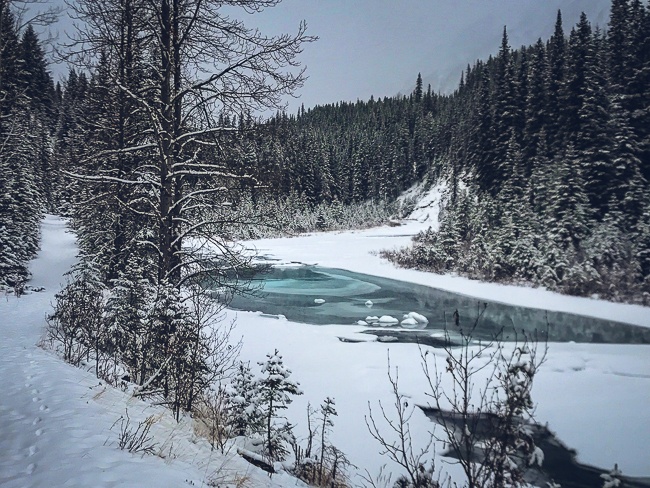
Banff winter hikes typically include snowshoes and, luckily, there’s an endless number of Banff snowshoe trails around town, in the Lake Louise area, and in adjacent national parks to snowshoe as much as you’d like.
Best of all, it’s easy to do! So even if you’ve never snowshoed before, you’ll get the hang of it quickly.
Snowshoes simply help you stay on top of the snow pack instead of sinking all the way down into it. The action is like walking but with your feet lifted a bit higher off the ground compared to regular walking steps.
The full-body aerobic workout will get your heart pumping and keep you warm even in the coldest temperatures and having the right winter hiking pants doesn’t hurt. But, no matter your physical shape, the incredible scenery in Banff National Park and the Canadian Rockies will take your breath away!
You can follow hiking trails or set your own path across lakes and into the backcountry. If you’re like me, snowshoeing will wind up being one of your favorite things to do in Banff in winter. There’s no better way to get out and explore the National Park and enjoy the winter landscapes blanketing the forests, mountains, and lakes.
Beginners may want to start with a snowshoe loop around Johnson Lake as it weaves through a variety of evergreen trees and provides sweeping views of Cascade Mountain and Mount Rundle. The trail is less than 2 miles around the lake and has hardly any elevation gain.
Other easy and moderate Banff snowshoe trails to try are the lakeside at Lake Louise, Tunnel Mountain Drive (near Surprise Corner Viewpoint!), and the trail to Peyto Lake along the Icefields Parkway. I snowshoed all of these trails and found it exhilarating to be breathing in the fresh mountain air and immersed in a side of nature fewer people take the time to enjoy.
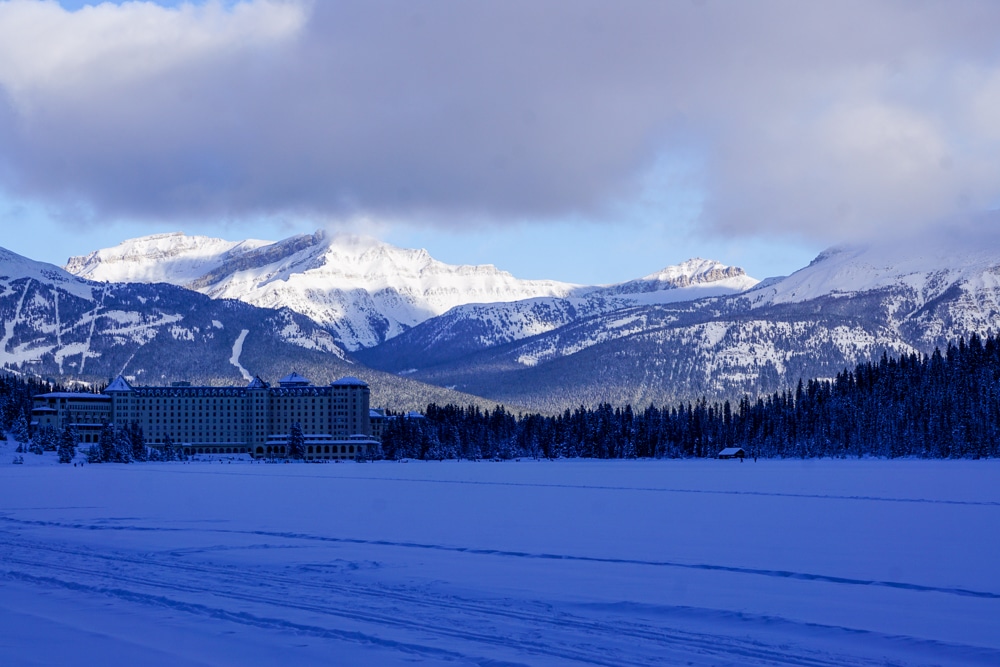
My personal favorite snowshoeing outing close to town was along the Spray River East Trail. The Spray River Valley was absolutely picture-perfect covered in white with icy bluish frozen chunks suspended in the river until spring.
Even better, the trail is quieter than others so don’t be surprised if you’ve found your own spot in Banff National Park’s winter wonderland. Keep an eye out for animal tracks if you snowshoe here. It was where I saw the most on any snowshoeing trail.
If you need snowshoes and poles, rent everything you need at Banff Adventures. I was so impressed with the quality of their gear and how quick and easy it was to get set up for the day. You can also rent gear for an extended period, too, so that you don’t need to return each day.
8. Hunt for the Parks Canada Red Chairs.
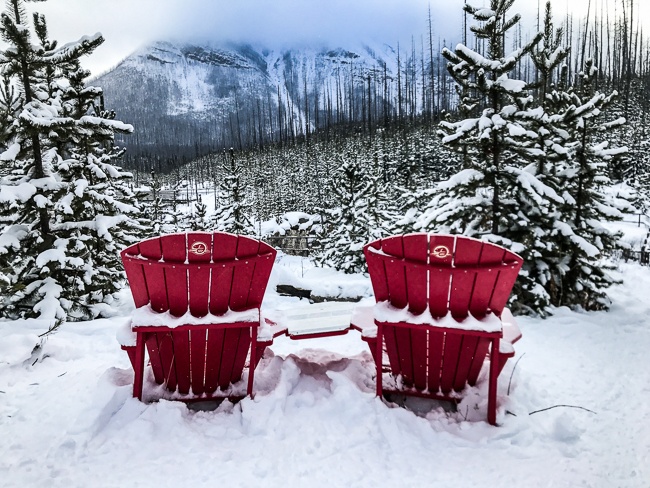
Are you up for a challenge?
Parks Canada has placed pairs of red chairs throughout Canada’s National Parks. When you find a set, you just can’t help but sit down…no matter how cold that chair is! Why?
Parks Canada has found spots with epic views of mountains, lakes, rivers, and all the natural beauty you can imagine in between. They’re meant for you to spend a few moments (or more if you’d like) in the chairs and let the tranquility of the scene before you settle your mind and your heart.
We found chairs alongside Two Jack Lake which was the perfect spot to gaze at Mount Rundle. Then, we snowshoed our way to another set of red chairs at Marble Canyon in nearby Kootenay National Park. (More on this below.)
No matter where you find them, it’ll be hard to tear yourself away from the views they offer.
9. Photograph a Gorgeous Banff Sunrise at Vermilion Lakes.
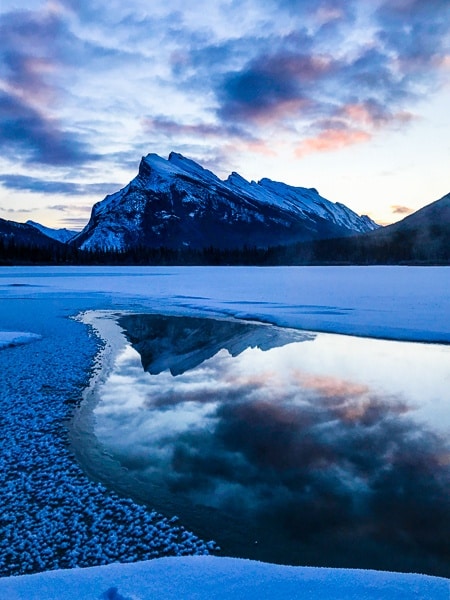
Just a few minutes outside of Banff’s downtown area, the Vermilion Lakes in Banff sits at the base of Mt Norquay.
Sulphur Mountain and Mount Rundle are perfectly positioned behind the lakes making for an incredible spot to watch the day’s first light brighten the sky and reflect the mountains on the lakes. When the sun finally peaks above the horizon, it’s nestled just so between the 2 mountains for a brilliant display of rays and warm light.
Yes, a winter’s morning Banff sunrise is bound to be quite cold, but the sun also rises later in winter. You can actually sleep to a respectable time, grab a coffee, and head to the Vermillion Lakes just in time to see the sky light up. It’s one of those things to do in Banff in winter that you don’t want to miss!
10. Finish your Banff Sunrise over Breakfast at Juniper Bistro.
After you’ve filled your camera with gorgeous sunrise photos, make the 2-minute drive to the Juniper Hotel and Bistro. The restaurant has a wall of windows facing the Vermillion Lakes and the Canadian Rockies beyond.
You can watch the sun lift higher and brighten the national park while eating a delicious breakfast guaranteed to get you ready for a day full of Banff winter activities.
ProTip: I’ve been fortunate to visit Banff National Park a few times. The Juniper Hotel in Banff is my top hotel choice to stay in the area. Juniper Bistro also serves absolutely delicious dinners, too. In winter, though, expect it to be already dark by the time you sit to eat. The fireplace and bar area make for a toasty warm spot for pre-dinner cocktails.
11. Drive along the Magnificent Icefields Parkway.
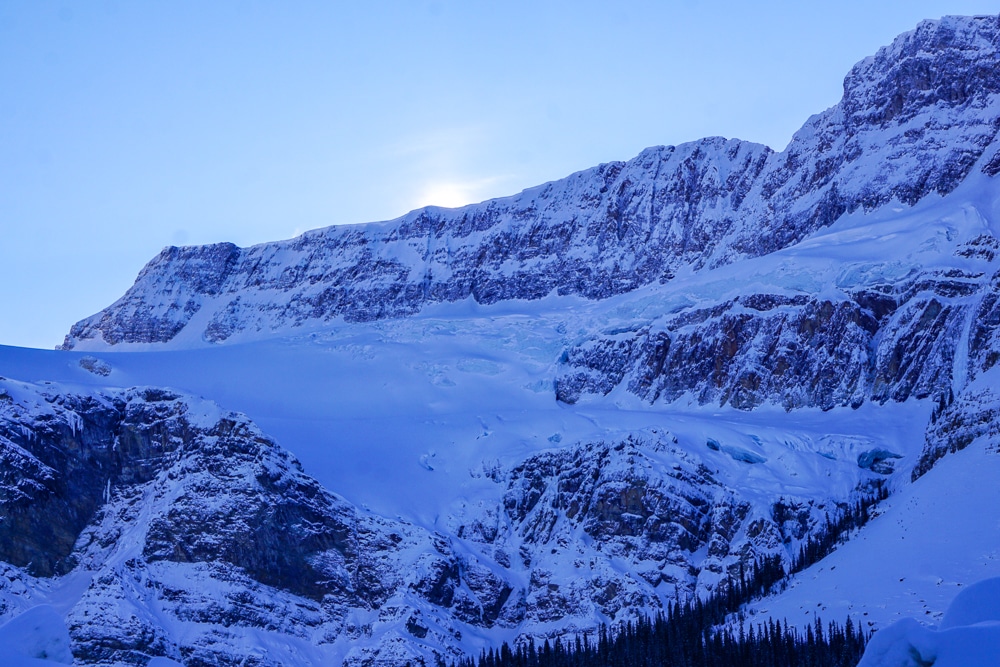
One of the most spectacular drives in the world, the Icefields Parkway is an absolute winter adventure!
You can simply drive along the Icefields Parkway (Highway 93 North) for the jaw-dropping views and scenic photo pull-offs. Or, my recommendation is to rent gear in Banff or from Wilson Mountains Sports in the village of Lake Louise so you can snowshoe or even cross-country ski into the snow-covered forests and over frozen lakes for your own expedition.
There are several Icefields Parkway points of interest in winter including the lakeshore of Bow Lake and Peyto Lake that are worth a stop. Both have beautiful snowshoe trails to explore regardless of your snowshoeing level. Just be sure to check the trail conditions before venturing out and pay attention to any avalanche-risk signs so you don’t snowshoe into these areas.
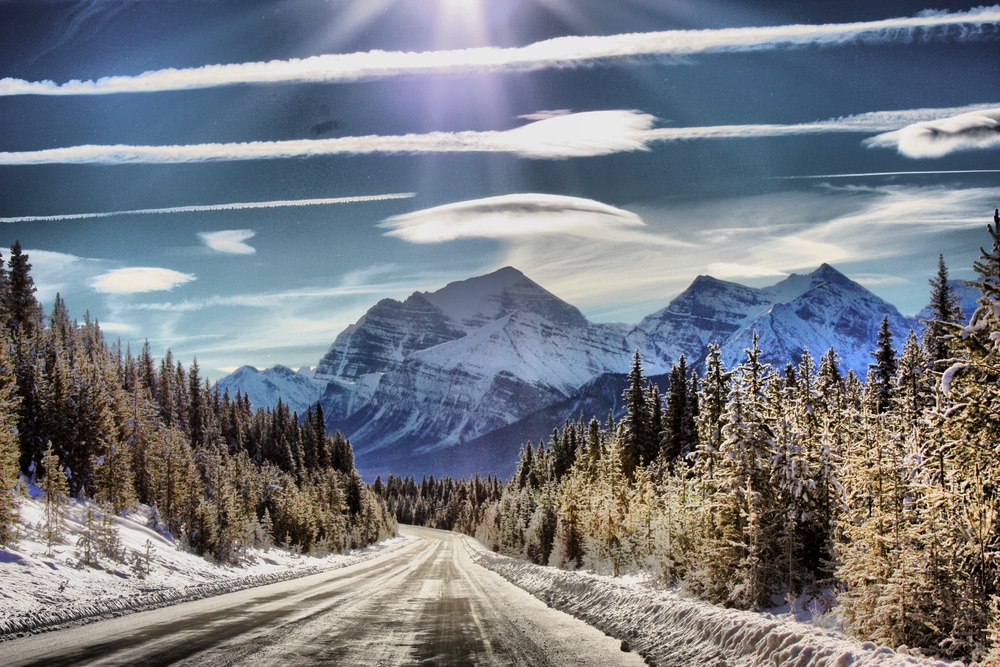
As you drive the Icefields Parkway in winter, don’t lose sight of the fact that you are in the Canadian Rockies in the winter. Check the Icefields Parkway road conditions and take them seriously. The road is maintained in the daylight hours and will likely have a layer of compacted snow or ice.
It’s mandatory to have snow tires to drive in the Banff area in winter. This includes the Icefields Parkway. Rental car companies know this. It’s also best to request a four-wheel drive when renting a car. Be sure the car includes an ice scraper.
Understand that Icefields Parkway hotels, gas stations, and other service stops will all be closed. Don’t go beyond the Lake Louise area without a full tank of gas. If you don’t have an ice scraper, get one in case you need it for sudden bad weather.
That being said, the Icefields Parkway is one of those can’t-miss things to do in Banff in winter! Check the weather for a bright blue sky day, wear the proper winter gear, have your cell phone and an extra battery, pack food and water, go slowly, and watch for wildlife. You can absolutely enjoy some of the incredible beauty the Icefields Parkway has to offer.
ProTip: Make sure you’re prepared for the outdoors in winter. This includes wearing layers and clothes made of fabrics that trap your body heat and wick away moisture.
12. Visit Jasper National Park, too!
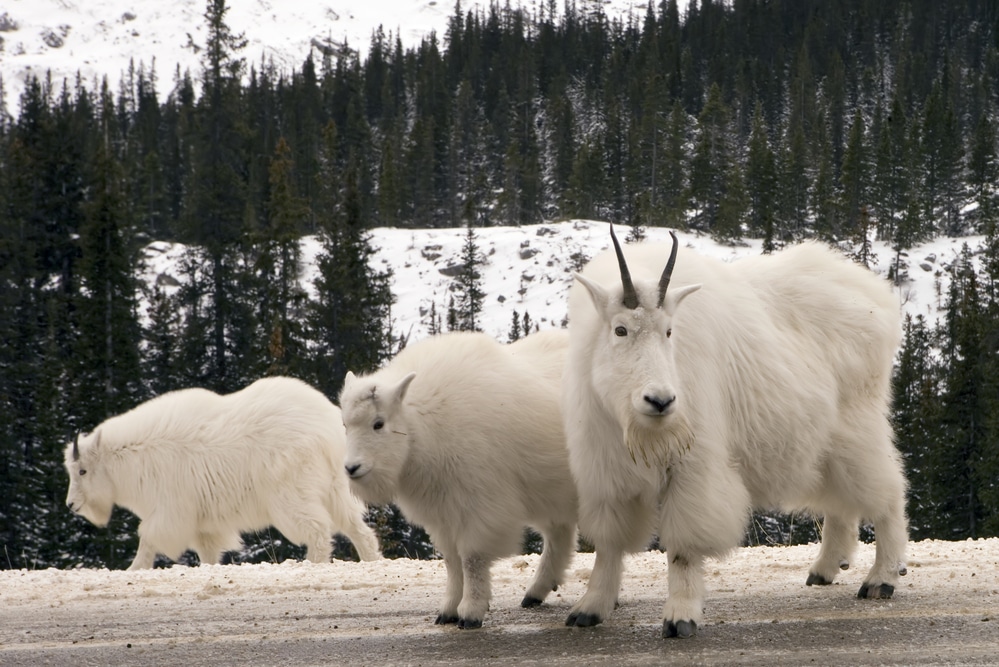
At the northern end of the Icefields Parkway, you’ll reach the town of Jasper and Jasper National Park. No matter the time of year, the town of Jasper has a more rugged feel compared to Banff’s refined downtown. However, both National Parks are blessed with unrivaled natural beauty in every season.
Jasper National Park in winter offers similar activities as the things to do in Banff in winter. You can snowshoe, ice skate, ice climb, do some cross-country and downhill skiing, and spot wildlife. All of this while surrounded by the Canadian Rockies and their alpine lakes and forests.
Jasper is quieter than Banff in winter. This is mostly because Banff has 3 ski resorts to Jasper’s 1 ski area, Marmot Basin. But that also means visitors who make the trip up the Icefields Parkway will find a wide-open winter mountainscape.
You can ice skate on Mildred and Pyramid Lakes throughout the winter as the snow is cleared when necessary. The snowshoeing and winter walking options are endless in Jasper National Park. The Maligne Lake area has both beginner and intermediate snowshoeing trails with postcard-perfect alpine scenery.
If you have time, I also recommend taking a guided walk into Maligne Canyon to see its frozen waterfalls and ice formations!
13. Hop aboard one of the Lake Louise Sleigh Rides.
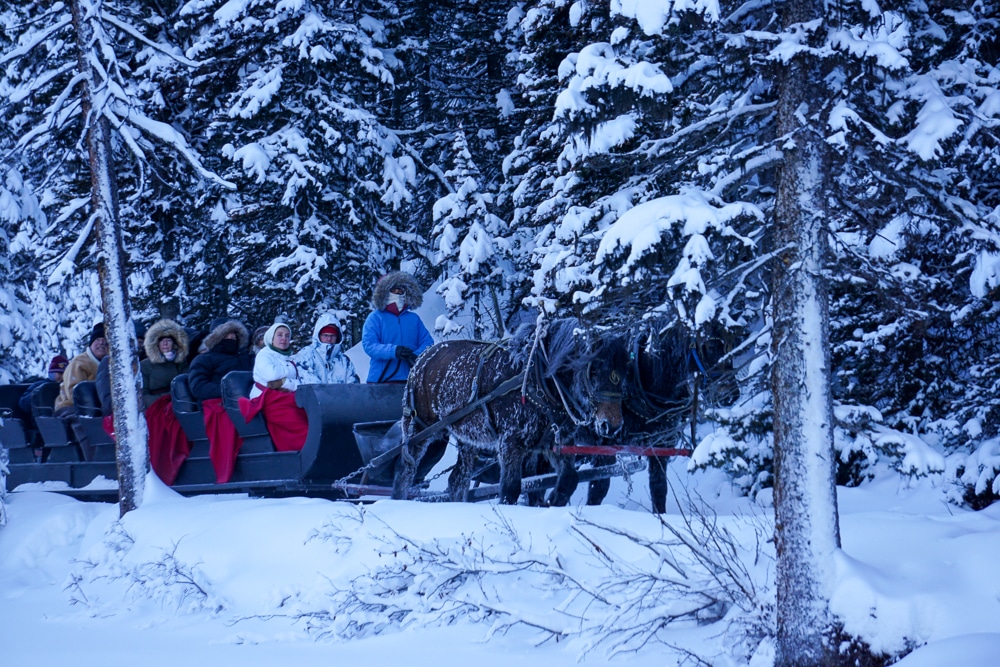
Lake Louise is gorgeous in any season, but in winter it’s like walking into a snow globe.
The Lake Louise ice castle, Lake Louise ice skating, and Lake Louise snowshoeing and cross-country skiing across the lake combine for a scene from a winter wonderland movie. Take all of this in from a horse-drawn sleigh ride on a path alongside the frozen lake.
Bundle up in a blanket or cozy up next to your travel companions and sit back to enjoy the roughly hour-long ride. If you’re lucky, someone will shake the snowglobe and flurries will fly!
14. Explore the Endless Natural Beauty on a few Banff Scenic Drives.
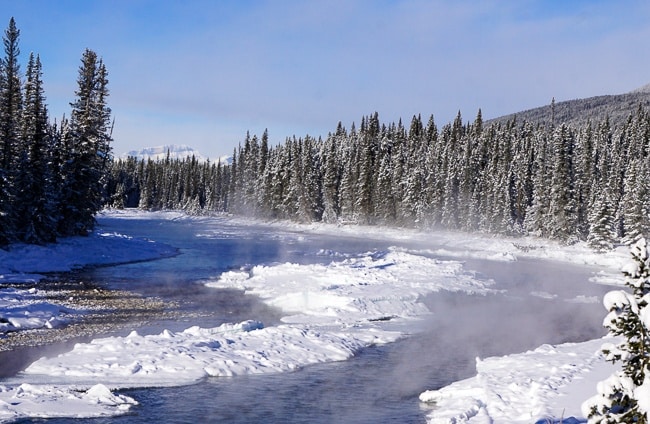
After days of skiing, snowshoeing, and ice skating, it’s nice to let your muscles recoup and take in the picturesque landscape from the warmth of your car.
The Icefields Parkway is the iconic scenic drive that rightfully deserves its own spot on this things to do in Banff in winter list. But, there are plenty of other can’t-miss Banff scenic drives.
The Bow Valley Parkway which connects Banff and the Lake Louise area weaves through the landscape with evergreens and mountains as far as the eye can see. It runs parallel to the Trans-Canada Highway and is a popular wildlife spotting drive. In winter, the narrow road and close-in evergreen trees sparkle after a few inches of fresh snow! Just take caution when driving in winter. The roads are cleared of snow but won’t be as clean as the highway.
The Lake Minnewanka Loop is one of the most popular areas in Banff National Park. In summer, you can drive the entire loop. However, in winter, just the eastern section is open to cars because the western side becomes a passageway for wildlfe.
The loop is perfect for capturing the immenseness of Lake Minnewanka and the snow-capped mountains all around. Along the way, admire frozen-over Two Jacks Lake or turn off to see Johnson Lake. Be sure to look for the bighorn sheep that often hang out in the area.

The hill up to the Mt. Norquay ski area also leads to the Norquay Lookout. You’ll gain a birds-eye view of the town and a perspective on how looming the mountains are surrounding it.
The Vermillion Lakes Road is short but a great drive to see the colors of dawn and dusk, as well as look for wildlife.
And, lastly, the 35 miles of TransCanada Highway that cover the distance from Banff to Lake Louise has to be one of the most beautiful actual highway drives on the planet.
15. Stop for a Photo at Morant’s Curve.
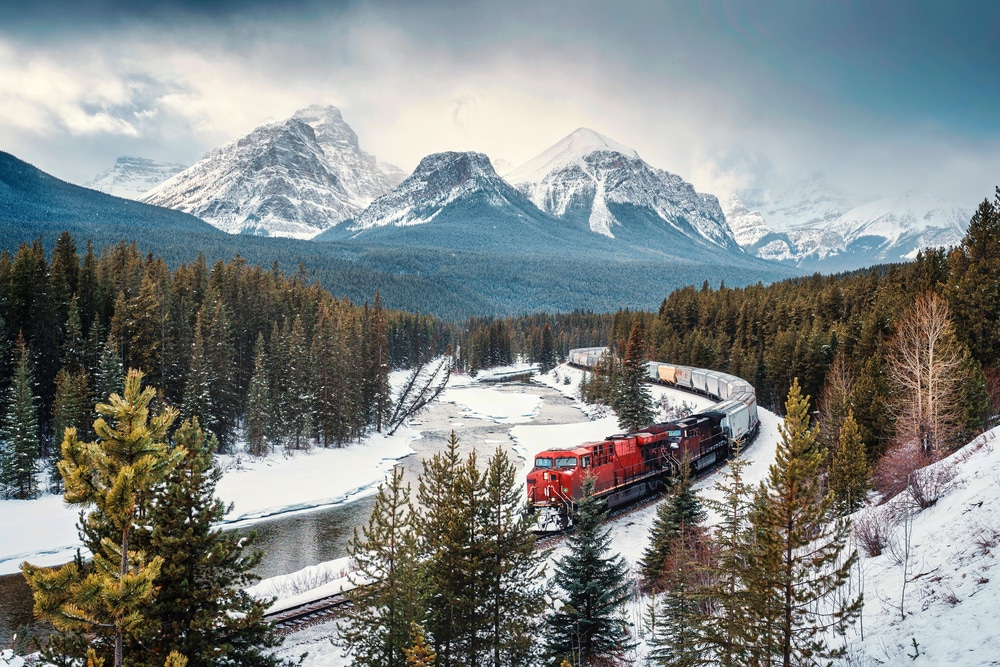
If you’re out on a scenic drive along the Bow Valley Parkway, plan a photo shoot at this iconic bend. This spot is where the Bow River bends and the roadside evergreens give way to an incredible view of Mount Temple.
What makes this photo spot even more special than others is the train track and the trains that run along it. Impressively long freight trains round this bend and combine with the landscape for one of the most classic photos in the entire Canadian Rockies.
The trick is to time your stop for when a freight train is passing by. But there are no public schedules of these trains so it takes a bit of luck and some patience to catch the right moment. To increase your odds, visit on a weekday and, if you’re really hoping for the train in your shot, give yourself an hour or so. Also, be sure to dress warmly!
I’ve visited Morant’s Curve in both summer and winter. Both are beautiful but I love what the scene looks like snow-covered! The spot is located on the Bow Valley Parkway closer to Lake Louise and there’s a small parking area just across the road. It’s one of those Banff winter activities that’s easy to do while exploring the area.
16. Do the Johnston Canyon Ice Walk.
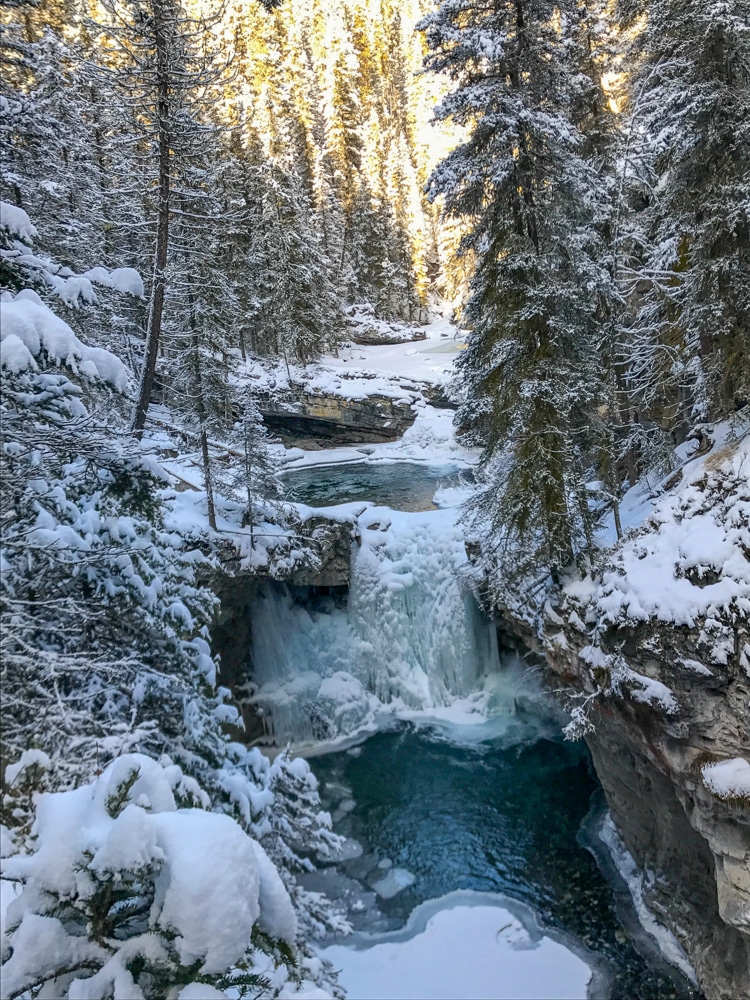
One of the most popular things to do in Banff in winter is to strap on a pair of ice cleats and do the Johnston Canyon ice walk. Johnston Canyon is just 30 minutes from the center of Banff off the Bow Valley Parkway. Its frozen waterfalls and frosted forest create a surreal winterscape that transports you to a world straight from the pages of Narnia!
Hike to Lower Falls and then follow the path to reach Upper Falls for about a 3-mile round trip adventure. Along the way, you’ll slope down towards the river and back up again passing waterfalls with cascades that have been turned to ice seemingly in an instant.
If you have more time and the trail conditions allow, continue on to the Ink Pots, small pools of mineral-rich water that colors the water. (Just be sure to have snowshoes to reach the Ink Pots and enough daylight hours to get there and back.)
The Johnston Canyon winter ice is also sought out by climbers looking to hone their ice climbing skills. On any given day, you’ll likely be able to watch climbers on their way up the frozen waterfall.
You can also take in the natural beauty on a guided ice walk in Johnston Canyon. It simplifies the day with the guide leading the way and providing cleats and poles.
17. Do some Banff National Park Wildlife Spotting.
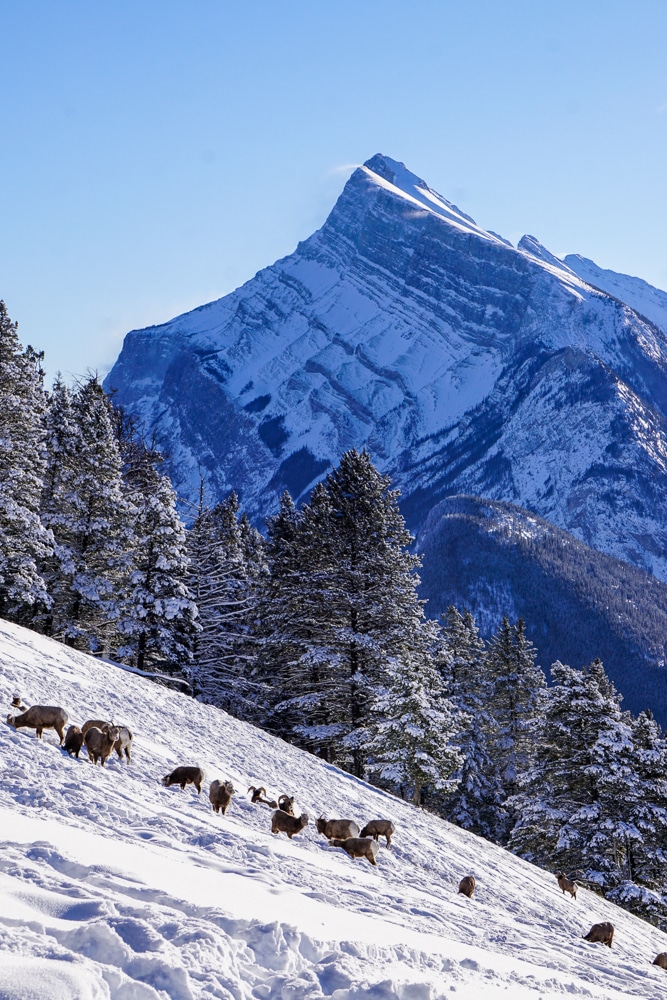
No matter which season you visit Banff and the Canadian Rockies, you’re entering the home of countless animals, large and small. In Banff, the most easily spotted are mule deer, bighorn sheep, and elk. (And it’s a thrill every time you see one!)
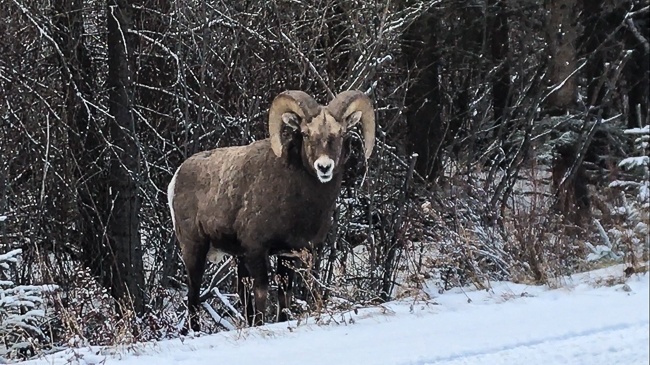
Moose, black bears, grizzly bears, wolves, lynx, and cougars also live in the area. The bears will be hibernating in the winter, but the others are still active in the winter months. So it’s important to always be alert while out snowshoeing or exploring away from busier, more populated areas.
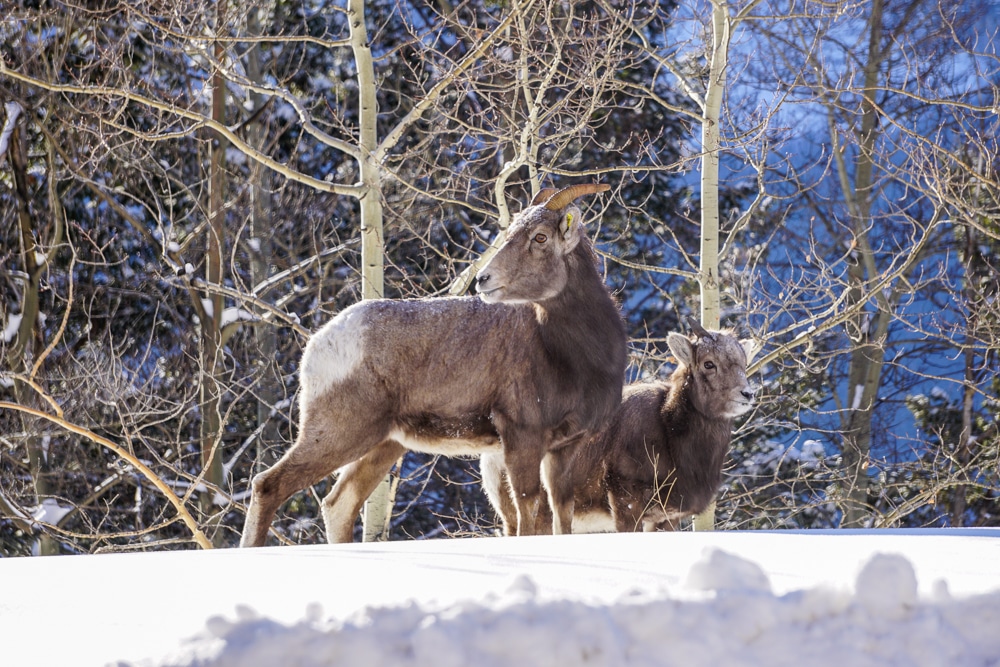
On this Banff winter trip, I was lucky enough to see wildlife along the Bow Valley Parkway, the Lake Minnewanka Loop, and the Mt. Norquay Lookout. Although you can see wildlife at any time, dawn and dusk are when you have a great chance of spotting something.
Please remember, you’re in their territory. Be respectful. Keep your distance. And, help keep the Banff National Park animals wild. Absolutely no feeding wildlife.
18. Discover the Best Banff Shops and Restaurants.
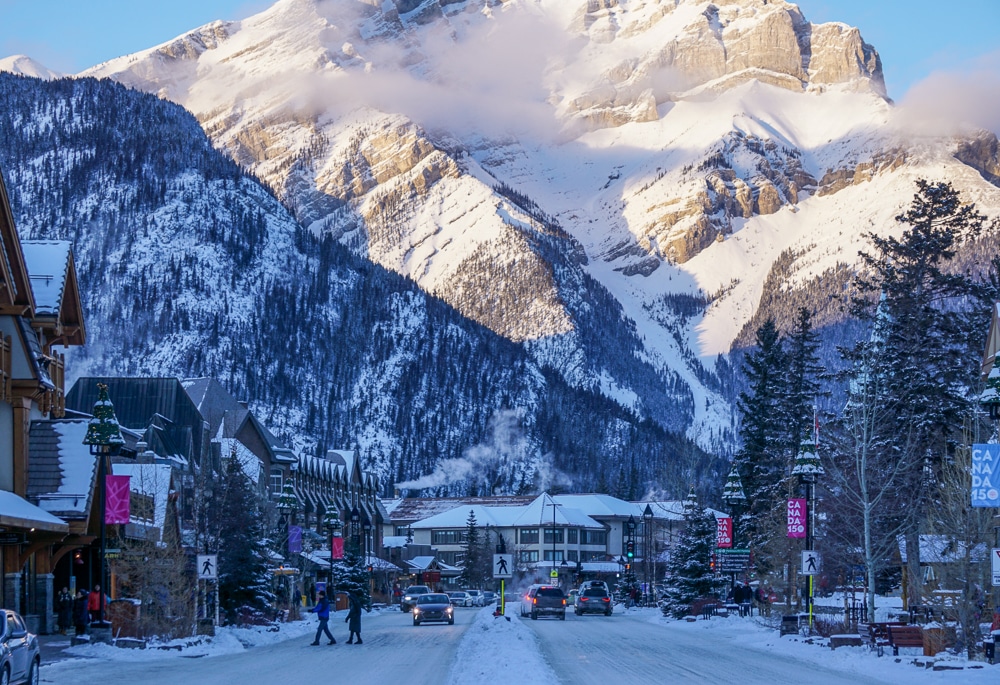
Banff’s pedestrian-friendly main thoroughfare, Banff Avenue and the smaller side streets stemming from it are lined with shops, restaurants, and bars. The matching alpine aesthetic of the building facades is complimented by the towering Cascade Mountain at the end of the road.
In winter, once the sun starts to set, visitors shop for treats at Banff’s Sweet Shoppe or look for the coziest Banff sweatshirt and fleece-lined socks complete with moose silhouettes. The shops will get you thinking about great gift ideas for friends & family who love the outdoors!
The center of Banff is walkable from most area hotels. In fact, it’s best to go on foot and avoid needing to park along the main avenue.
When thirst or hunger strikes, pop into a bar or restaurant for an apres-ski/adventure drink and food ranging from pizza to steak to fondue and everything in between. There is no shortage of delicious places to indulge in some cozy comfort food as you recount the day’s adventures and wind down the day.
19. Don’t Miss Out on a Dinner at Park Distillery in Banff.
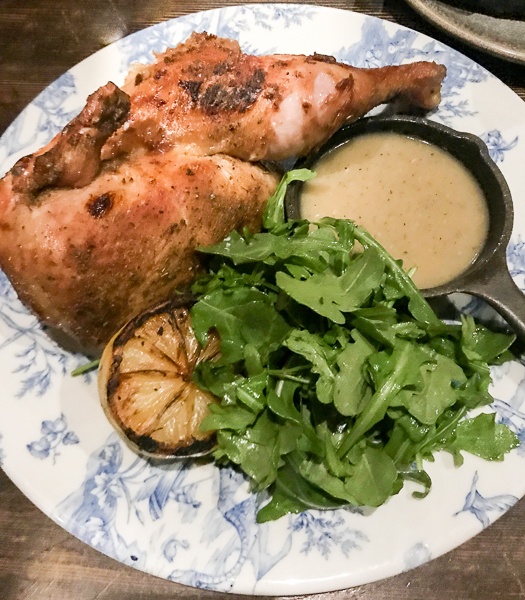
Speaking of places to eat in Banff, it would be unfair if I didn’t share my top pick. Of all the restaurants in Banff, my heart belongs to just one, Park Distillery. So much so, that I couldn’t leave Banff without returning for a second time.
Dubbed as campfire cuisine, the menu has wood-fired dishes like roast chicken, seared salmon, and vegetable sides like creamed kale and grilled carrots. Ingredients are locally sourced from nearby farms and expertly prepared. Your campfire cookout never tasted so good!

I was a satisfied happy camper with my veggie bowl containing fava bean falafel and egg!
My husband and I even fork-fought for the last chunk of roasted squash. The coziness of the fireplaces inside and the comfort from the warm, fresh food strikes the perfect balance on a winter night after a day of adventure in Banff National Park.
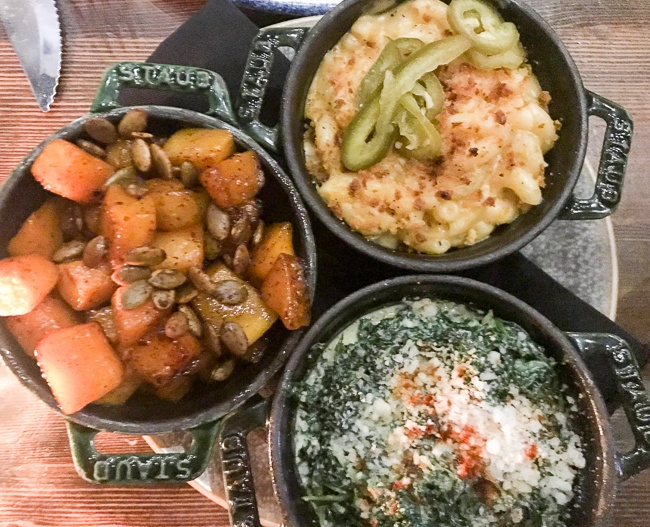
Best of all, Park Distillery is an actual distillery. Vodka, gin, and rye are all handmade in Banff in small batches with grain from local high-altitude farms and glacier-fed water. If you’re interested in the process, Park Distillery offers free daily tours at 3:15 pm.
20. Soak in the Banff Upper Hot Springs.
Banff National Park was initially established to protect the natural hot springs that had been used by Indigenous peoples for years for ceremonies and healing. The mineral-rich waters come from deep within the Earth and can be as hot as 118 degrees Fahrenheit during the winter months.
Not coincidentally, the naturally heated mineral water is also the perfect remedy day or night to soak tired muscles and restore your body’s defenses from the winter cold. All while gazing at the mountain peaks surrounding Banff. Sounds amazing, right? It is!
Tickets are available on a first-come-first-serve basis at the hot springs reception area. Bring a bathing suit. Towels can be your own (which saves money) or rented there. There are also lockers where you can store your belongings.
During the winter, the Banff Upper Hot Springs hours are from 10 a.m. to 10 p.m. each day. It’s also open on all Canadian holidays including Christmas and New Year’s Day.
21. Meet the dogs at Yamnuska Wolf Sanctuary.
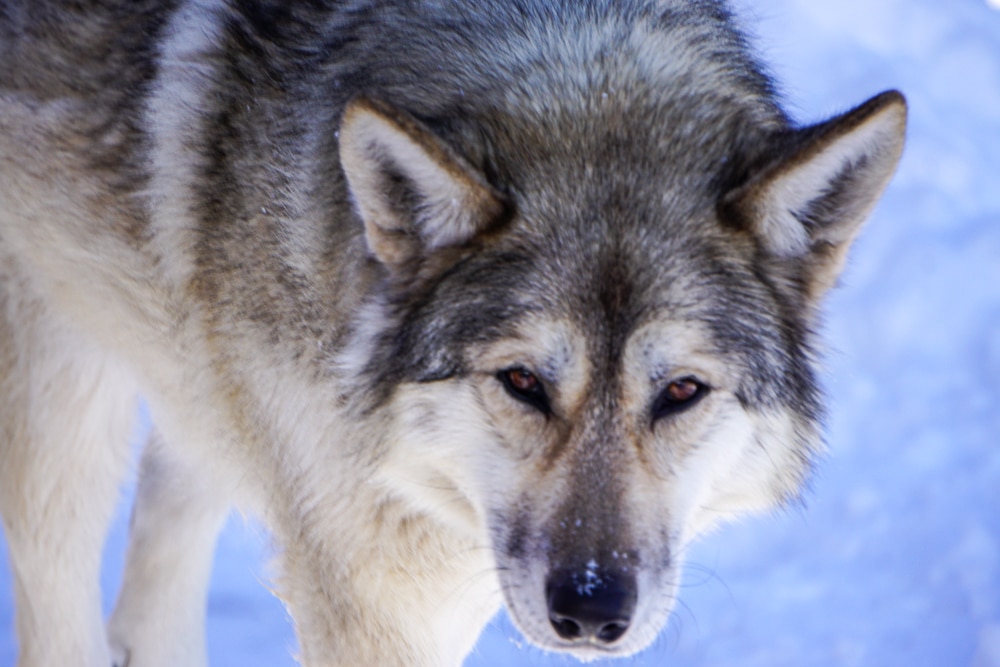
You’re all but guaranteed to see some wildlife while you’re in Banff. There are animals all around from, bighorn sheep and elk to cougars, wolves, and bears (hibernating in winter).
Wolves, in particular, are elusive. So it’s unlikely you’ll see one in the wild. The next best thing, though, is to visit the Yamnuska Wolfdog Sanctuary not far from Banff.
This nonprofit organization takes in wolfdogs which are a hybrid between a domestic dog and a species of wolf. Typically the dogs arrive at the sanctuary once their former owners realize they aren’t able to keep the dog legally or can’t manage the dog their puppy has grown into.
On an interactive tour of the sanctuary (what I did), you’re escorted and educated by an expert wolfdog caretaker. You’ll go inside a couple of the enclosures for an immersive experience with some of the dogs. It was a thrill to interact with some of the dogs, as well as to really learn and observe physical and behavioral trait differences between wolves and dogs.
If you’re a dog or wildlife lover like me, your visit with the dogs at Yamnuska to learn more about dogs, wolves, and wolfdogs will be one of your most memorable things to do in Banff in winter.
22. Hunt for the Banff Northern Lights.
Seeing the Northern Lights anywhere is an experience on many a bucket list.
It’s truly a wondrous night sky event. When the Banff National Park Northern Lights come out for a show, it’s nearly impossible to take your eyes off the sky.
Head away from sources of artificial light for your best chance to see the green glow. Lake Minnewanka is a dark spot, close to town, with wide open skies over the lake. You can check the odds of the Banff Aurora Borealis appearing on this Aurora Watch website and even get alerts from some hotels if there’s Aurora activity.
23. Go Dog Sledding from Lake Louise or Banff National Park.
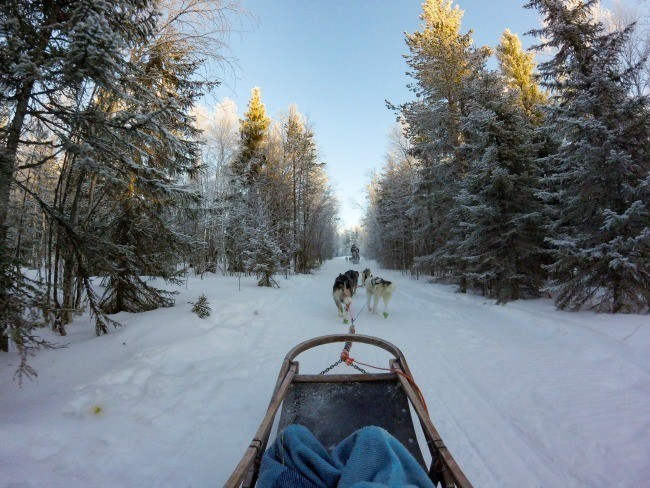
Another one of the most popular things to do in Banff in winter is a dogsledding tour.
Unfortunately, this is the only activity I ran out of time for on my trip. However, I have gone dog sledding in Finland and can speak to the experience.
The rush of the sled as it glides over the snow and races through a snowy forest is unforgettable. The dogs yip and yap, excited to go. You’ll recognize not only the thrill of being whisked through a winter forest, but also the missing roar of a motor making all of it happen.
You’ll inevitably connect with the dogs, too! It’s impossible not to appreciate their enthusiasm, work, and how loveable they are.
There are several tour options to choose from, with dog sledding from Lake Louise or Banff National Park available. One of the most popular tours passes over the Continental Divide on a 90-minute ride that also includes stops for taking photos.
24. Snowshoe in Marble Canyon.
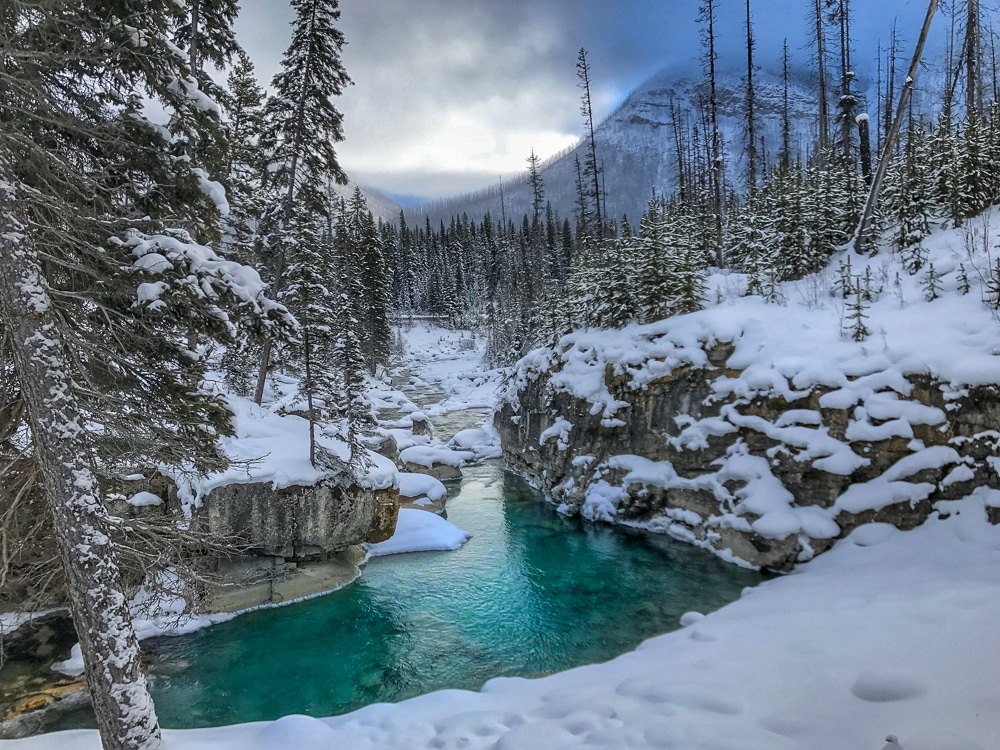
Just over the Alberta line in British Columbia, Yoho and Kootenay National Parks sit waiting to be explored. They’re easy day trips from Banff and are generally quieter than Banff and Lake Louise.
And while you could plan another trip just to explore British Columbia and its natural beauty, Marble Canyon in Kootenay National Park is too pretty to miss when you’re already so close visiting Banff in winter.
Marble Canyon is just across the Continental Divide and only 40 minutes or so from the center of Banff. The trail is just under 1 mile out and back from the trailhead. It’s an easy route with very little elevation gain. Depending on how long you spend taking photos and gushing over the landscape, this could easily be a quick 30-minute to 1-hour activity.
Depending on the time of year and the weather leading up to your winter visit, you may need snowshoes or ice cleats to keep your footing along the trail and over the 7 bridges that cross the canyon. When we visited on around Christmas, there was snow so we used our snowshoes.
Marble Canyon has been cut over years and years of being pounded by the water that flows through. It’s here where the water mixing from the Vermilion River and Tokumm Creek creates an arctic turquoise color that looks beautifully unreal against the white-blanketed canyon.
If you go, look for the red Parks Canada chairs!
25. Discover Hidden Away Emerald Lake.

Similarly in nearby Yoho National Park, Emerald Lake (aptly named because of its turquoise color in summer) and the surrounding snowy forests seem to have sprung from a picture-perfect winter landscape painting. The area is absolutely stunning!
Emerald Lake Lodge is situated on the lake and, from the moment you park, the views of the lodge against the backdrop of the mountains and Emerald Lake are incredible. In fact, the lodge is open year-round and is considered one of the best (and most romantic) places to stay in the Canadian Rockies.
Situated within Yoho National Park, you’ll find trails for snowshoeing, cross-country skiing, or simply finding snow-covered scenic spots to take photos and marvel over the view. The popular Emerald Lake loop trail is one such path. It’s a 3.25-mile journey around the lake allowing a great perspective of the lodge and the snowy forests.
When we visited at the end of December, the lake wasn’t frozen over yet but plenty of snow had fallen. It was great fun to head into the forest with our snowshoes to explore! If you don’t have gear, there is a small rental shop on site.
ProTip: We visited Emerald Lake and Marble Canyon on the same day. With a morning start, you can use the full day to get a taste of Kootenay and Yoho National Parks before heading back towards Banff or Lake Louise.
How to Get to Banff
The town of Banff and Banff National Park are in the Canadian Province of Alberta, the heart of the Canadian Rockies. For reference, Alberta borders the U.S. State of Montana to the south, British Columbia to the west, Saskatchewan to the east, and the Northern Territories to the north.
Most visitors get to Banff by flying into the city of Calagary with its well-served international airport. From there, Banff and Banff National Park are just 90 minutes by car to the west along the Trans-Canada Highway.
Important Banff Winter Tips
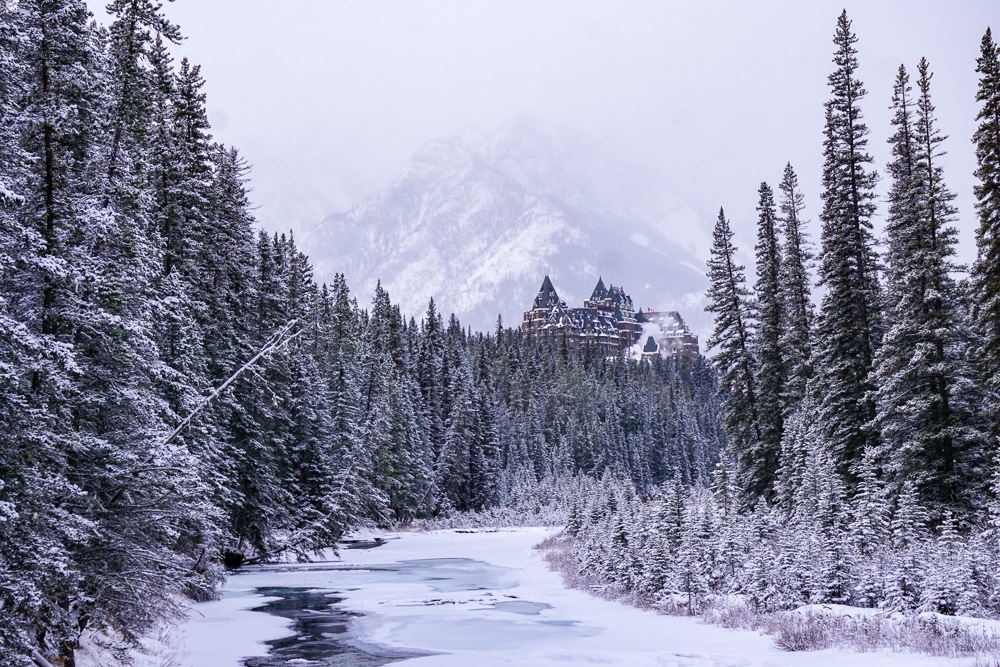
To visit Banff National Park and the other parks in the area, you’ll need a Parks Pass. This can be purchased online, at the Banff National Park gate, and at the Visitor Centers in town.
There are Day Passes and Discovery Passes. Depending on how long you plan to stay, it may be cheaper to buy a Discovery Pass which is valid for 12 months at over 80 Parks Canada spots across Canada.
It’s also important to remember you are in a wild, natural setting in the winter. This means being prepared for the unexpected.
Where to Stay in Banff
I’ve taken a few trips to Banff and have had great stays each time. Most people choose to stay in the immediate Banff area or in Lake Louise. You’ll also find more options, some more affordable, in nearby Canmore.
I absolutely loved my stay at The Juniper Hotel and would gladly stay there again. Although it’s just outside the Banff town center, the hotel’s coziness and views are perfect. I’ve also had great stays at the Banff Aspen Lodge and the Fox Hotel & Suites which are both in downtown Banff
For luxury stays, consider the Fairmont Banff Springs Hotel or the Fairmont Chateau at Lake Louise.
You can also research current Banff hotel prices on TripAdvisor.
Questions about Banff in the Winter
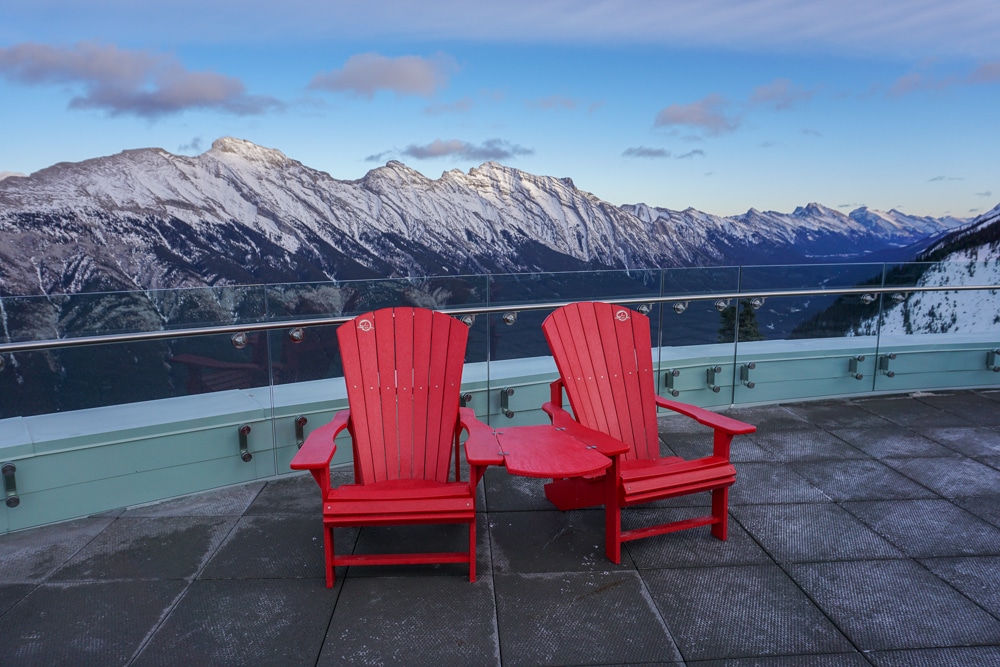
Banff in January is the coldest time. Average temperatures can hover around 5 degrees Fahrenheit. Banff’s winter air is dry so this does help in managing the cold. However, you also have to factor in wind chill and colder temperatures at higher elevations.
The access road to Moraine Lake is closed in the winter and it is not recommended to snowshoe there because of the avalanche risk. Moraine Lake is best visited in the summer season when it’s possible to ooh and ahh over its stunning blue water.
Driving in Banff in winter requires attentiveness and caution. By driving slowly, leaving distance between you and the cars around you, and checking current road conditions, you can drive safely around the area. When renting a car, confirm your rental has snow tires.
Plan at least 5 days in Banff in winter, and if you can, stay for a week. Not only is there plenty to see and do in Banff during wintertime, but you also want to factor in driving times between places, possible inclement weather days, and some downtime to rest your leg muscles from skiing, snowshoeing, and ice skating.
Things to Do in Banff in Winter: Time to Start Planning!
No need to wonder anymore about what to do in Banff in winter or, better yet, what to do in Banff if you don’t ski!
Banff National Park and the Canadian Rocky Mountains are a winter wonderland full of adventures and gorgeous natural settings. To see Banff in the winter is to see the landscape transform itself into a snowy paradise with endless winter activities and sights that truly reward anyone who ventures out and uses the winter season to their advantage!
Which Banff winter activities would you like to do?
Like this post? Please share it on social media using the share buttons below.
Disclosure: I was a guest of Banff Lake Louise Tourism. As always, all opinions are my own.
